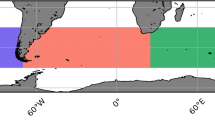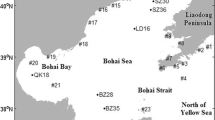Abstract
The fields of currents in open basins are studied with the use of a mathematical model of ocean hydrodynamics. The area of the Hawaiian Islands is taken as an example. The model, based on three-dimensional equations of thermohydrodynamics, is solved for a domain with open boundaries, at which adaptive boundary conditions are set. We analyze the results of numerical experiments with given monthly mean climatic conditions at the ocean surface and open lateral boundaries with consideration for tides M 2 and K 1. A comparison of the model solutions and observational data shows that the model can realistically reproduce the mean parameters of the ocean state and their variability. The model solutions for the given area were found to have a northward current in the upper oceanic layer. This current clearly manifests itself in averaged fields. The characteristics of averaged currents indicate that the upper 100–150-m layer between the islands of Hawaii and Maui as well as between the islands of Molokai and Oahu is characterized by water transport from the west to the east side of the ridge of islands. The results obtained and the model proposed can be used to monitor physical fields of the ocean.
Similar content being viewed by others
References
V. G. Bondur, Aerospace Methods in Modern Oceanology, Ed. by M. E. Vinogradov and S. S. Lappo (Nauka, Moscow, 2004), pp. 55–117 [in Russian].
V. G. Bondur, “Complex Satellite Monitoring of Coastal Water Areas,” in Proceedings of 31 International Symposium on Remote Sensing of Environment (St. Petersburg, 2005).
Atlas of Oceans. Pacific Ocean, Ed. by S. G. Gorshkov (USSR Ministry of Defense, Moscow, 1974) [in Russian].
Atlas of Hawaii, Ed. by S. P. Juvik and J. O. Juvik (Univ. of Hawaii Press, Honolulu, 1998).
W. White, “A Narrow Boundary Current along the Eastern Side of the Hawaiian Ridge: The North Hawaiian Ridge Current,” J. Phys. Oceanogr. 13, 1726–1731 (1983).
J. M. Price, M. L. Van Woert, and M. Vatousek, “On the Possibility of a Ridge Current along the Hawaiian Islands,” J. Geophys. Res. C 99, 14 101–14 112 (1994).
F. M. Bingham, “Evidence for the Existence of a North Hawaiian Ridge Current,” J. Phys. Oceanogr. 28, 991–998 (1998).
E. Firing, “Currents Observed North of Oahu during the First Five Years of HOT,” Deep-Sea Res. 43, 281–303 (1996).
E. Firing, B. Qiu, and W. Miao, “Time-Dependent Island Rule and Its Application to the Time-Varying North Hawaiian Ridge Current,” J. Phys. Oceanogr. 29, 2671–2688 (1999).
B. Qiu, D. A. Koh, and C. Lumpkin, “Flament. P. Existence and Formation Mechanism of the North Hawaiian Ridge Current,” J. Phys. Oceanogr. 27, 431–444 (1997).
W. C. Patzert, Eddies in Hawaiian Waters (Hawaii Inst. of Geophysics, Hawaii, 1969), No. 69-08.
G. T. Mitchum, “The Source of 90-Day Oscillations at Wake Island,” J. Geophys. Res. C 100, 2459–2475 (1995).
C. L. Holland and G. T. Mitchum, “Propagation of Big Island Eddies,” J. Geophys. Res. C 106, 935–944 (2001).
P. Flament, Ocean Atlas of Hawaii (1996); http://radlab.soest.hawaii.edu/atlas/currents.html
A. S. Sarkisyan, Principles of Theory and Calculation of Ocean Currents (Gidrometeoizdat, Leningrad, 1966) [in Russian].
A. S. Sarkisyan, Numerical Analysis and Prediction of Sea Currents (Gidrometeoizdat, Leningrad, 1977) [in Russian].
K. Bryan, “A Numerical Method for the Study of the Circulation of the World Ocean,” J. Comput. Phys. 4, 347–376 (1969).
Yu. L. Demin and R. A. Ibrayev, “Model of Ocean Dynamics,” in Numerical Models and Results of Calibration Calculations of Currents in the Atlantic Ocean (Inst. of Numerical Mathematics of the Russian Academy of Sciences, Moscow, 1992), pp. 42–95 [in Russian].
R. A. Ibraev, “Reconstruction of Climatic Characteristics of the Gulf Stream techeniya Gol’fstrim,” Izv. Akad. Nauk, Fiz. Atmos. Okeana 29, 803–814 (1993).
A. S. Sarkisyan, “Analysis of Model Calibration Results: Atlantic Ocean Climatic Calculations,” J. Mar. Syst. 5, 47–66 (1995).
R. A. Ibrayev, “Model of Enclosed and Semi-Enclosed Sea Hydrodynamics,” Russ. J. Numer. Anal. Math. Model. 16, 291–304 (2001).
WOA2001. World Ocean Atlas 2001. High resolution (1/4 degree) Temperature and Salinity Analyses of the World’s Oceans. Version 2. http://www.nodc.noaa.gov/OC5/WOA01/
F. Roske, An Atlas of Surface Fluxes Based on the ECMWF Re-Analysis—A Climatological Dataset to Force Global Ocean General Circulation Models (Max-Planck-Inst. fur Meteorologie, Hamburg, 2001).
J. K. Gibson, P. Kallberg, S. Uppala, et al., ERA-15 Description (Version 2), ECMEF Re-Analysis Project Report Series, No. 1 (1999).
G. I. Marchuk and B. A. Kagan, Dynamics of Ocean Tides (Gidrometeoizdat, Leningrad, 1983) [in Russian].
A. Gill, Atmosphere-Ocean Dynamics (Academic, New York, 1982; Mir, Moscow, 1986).
D. Praudman, Dynamic Oceanography (Wiley, London, 1953; Inostrannaya Literatura, Moscow, 1957).
A. L. Perkins, L. F. Smedstad, D. V. Blake, et al., “A New Nested Boundary Condition for a Primitive Equation Ocean Model,” J. Geophys. Res. C 102, 3483–3500 (1997).
P. Marschesiello, J. C. McWiliams, and A. Shchepetkin, “Open Boundary Conditions for Long-Term Integration of Regional Oceanic Models,” Ocean Model. 3, 1–20 (2001).
K. Wyrtki, “Eddies in the Pacific North Equatorial Current,” J. Phys. Oceanogr. 12, 746–749 (1982).
UNESCO. Seventh Report of the Joint Panel on Oceanographic Tables and Standards, UNESCO Techn. Papers. Mar. Sci., No. 24, 39–54 (1976).
W. H. Munk and E. R. Anderson, “Note on the Theory of the Thermocline,” J. Mar. Res. 7, 276–295 (1948).
W. H. Raymond and H. L. Kuo, “A Radiation Boundary Condition for Multi-Dimensional Flows,” Q. J. R. Meteorol. Soc. 110, 535–551 (1984).
I. Orlansky, “A Simple Boundary Condition for Unbounded Hyperbolic Flows,” J. Comput. Phys. 21, 251–269 (1976).
Author information
Authors and Affiliations
Corresponding author
Additional information
Original Russian Text © V.G. Bondur, R.A. Ibrayev, Yu.V. Grebenyuk, G.A. Sarkisyan, 2008, published in Izvestiya AN. Fizika Atmosfery i Okeana, 2008, Vol. 44, No. 2, pp. 239–250.
Rights and permissions
About this article
Cite this article
Bondur, V.G., Ibrayev, R.A., Grebenyuk, Y.V. et al. Modeling the sea currents in open basins: The case study for the Hawaiian Island region. Izv. Atmos. Ocean. Phys. 44, 225–235 (2008). https://doi.org/10.1134/S0001433808020102
Received:
Accepted:
Published:
Issue Date:
DOI: https://doi.org/10.1134/S0001433808020102




